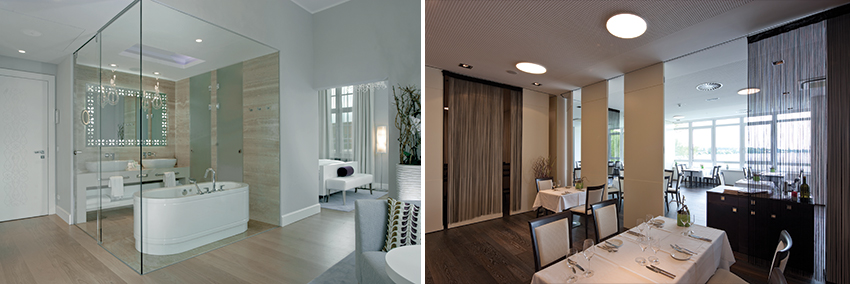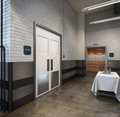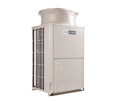Hospitality and Retail Design Update
Opening Glass Walls
Opening glass walls go beyond conventional windows and instead use large, door-sized glass panels that can be readily opened or closed on demand. Like any other type of building fenestration, this system does not carry any structural load from the building, but is reliant on being appropriately attached to the building and operates within a structurally supported opening.
In hospitality settings, opening glass walls provide exceptional opportunities for flexible, multipurpose, economical, and enticing spaces. In hotels, for example, an opening glass wall enables the creation of large, inviting entrances in the lobby area, thus eliminating the barrier between the entrance and the lobby and allowing a free flow of customer traffic. They can also be used as interior divisions in hotels and restaurants to allow personnel to quickly and easily incorporate or close retail space, dining areas, bars, and meeting rooms. Such a separation might be appropriate between a time-specific breakfast area and the hotel public space after the food service has concluded. Or it might be a way to quickly create private banquet rooms, meeting rooms, or retail spaces that can still transmit light but significantly reduce sound transmission.
In retail settings, a wide-open entrance similarly eliminates barriers by creating a seamless transition between street or mall and the store, helping to attract customers inside and increasing sales. The wide-open storefront also expands merchandising areas by utilizing street fronts, sidewalks, and mall walkways to display movable racks and bins that can roll easily through the spacious opening. When it is time to close up for the day, the opening glass wall continues to showcase the interior and provides a secure, energy-efficient, transparent facade that seals tight as a dust-control measure after hours. Restaurants are also able to benefit from opening glass walls that can increase seating capacity and boost revenue by opening a restaurant’s interior to surrounding outdoor spaces, such as the street, a patio, or balcony. In mixed-use conditions, it is possible to create unique and memorable indoor/outdoor dining atmospheres for shoppers to enhance and extend their shopping experiences.
When opening glass walls are used as part of the building enclosure, the performance of these systems is clearly critical. Comparing manufacturers and specifying opening glass walls that can stand up to the daily rigors of a hospitality or retail building is important. Equally, the opening glass wall needs to show documented capabilities to appropriately withstand the challenges of wind, water, extreme temperatures, forced entry, impact, acoustics, and structural load. This includes attention to details such as multipoint locking entry doors that may be equipped with extra-long, tamper-resistant locking rods between panels to ensure they meet or exceed forced-entry testing for commercial grade door panels. It may also include built-in adjustment and compensation points to ensure continued ease of operation if any building settling occurs.

Photos courtesy of NanaWall Systems
Opening glass walls can be used in hospitality, retail, or restaurant settings to either open an indoor space up completely to an outdoor area (left) or be closed to seal off the exterior of the building when the weather is not favorable (right).
Creative Interior Spaces
Hospitality and retail spaces are often in need of interior spaces that are space efficient, while still meeting differing and variable needs. This is particularly true in individual guest rooms where design criteria need to blend with space efficiency. One way to approach that efficiency is to use interior sliding or folding door hardware instead of swinging doors on such things as closets or bathrooms. Sliding doors do not intrude into the room (unlike pivot/swinging doors when opening), which is a benefit to hotels with rooms that have a smaller footprint where every square foot counts. Further, the materials used on sliding doors can vary such that dramatic finishes or even full glass can help enhance and bolster the overall interior design of a room or suite.
In public areas, sliding doors can not only allow access between spaces, they can create appropriately sized, transformative spaces for events, displays, or operations. When closed, sliding or folding multiple door panels produce privacy on demand. This helps control the use of spaces through concealment, while still providing easy access when needed. When the sliding doors are opened by users or facility staff, larger spaces can be easily created. Glass in various forms for the door panels is popular since it can introduce natural or borrowed light. This means that the space being enclosed does not need to be dark simply because the doors are shut. If privacy is needed, then it is entirely possible to use glass that is translucent, tinted, or otherwise treated to achieve the desired effect. And the size of the opening to the space does not need to be a limiting factor since sliding hardware systems are available to accommodate openings ranging from fairly small (5 or 6 feet) to very large (greater than 18 feet).
One of the key differences between different types of sliding door systems is the ease of operation, which usually comes down to precision engineering and very good quality hardware. The sliding hardware systems are usually made out of either steel or aluminum and include rollers, tracks, plates, pulls, and locks. The important part is that it produces smooth and quiet sliding properties with an ease of operation yet is durable enough to provide extended life spans in commercial settings. When it comes to meeting accessibility or ADA requirements, the hardware for sliding door systems usually excel here, too. Most sliding hardware systems require very little force to operate, can be top hung to eliminate any sill or threshold barrier, and have no bottom rail height restrictions since sliding doors move completely out of the way. This aspect of creating a complete opening may also eliminate the need for larger access areas commonly required for swinging doors, such as side clearances and approach aisle width.
There are several common operational options for this type of large-format sliding or folding door system. A standard version provides a straight sliding panel usually adjacent to a fixed panel such that half of the total width can be opened. Symmetric, bi-parting doors/panels will also allow an opening of about half of the total width but places the opening in the middle instead of the side. This is achieved by placing two bi-parting panels in the middle that slide outward from the center over two similarly sized, fixed panels. Telescopic systems allow multiple panels to be moved and stacked on one or two sides or be recessed into a wall opening such that the whole system seems to disappear. All of these systems work exceptionally well in guest rooms for bathroom doors, closet openings, and room separation. They also provide a lot of flexibility in common areas, such as breakfast rooms, restaurants, bar areas, and meeting rooms.

Photos courtesy of Hawa Group Americas Inc.
Sliding hardware systems, whether using full glass or opaque panels, can be used in hospitality and retail settings to define space in guest rooms and create flexible use of spaces in common areas.
Notice

www.amerlux.com

www.mockett.com/levity

www.hawa.com

www.inprocorp.com/ipc

MitsubishiPro.com/ready/innovation

www.nanawall.com/applications/commercial

www.pellacommercial.com/monumental-windows

www.hooksandlattice.com/custom-marek-planters.html









